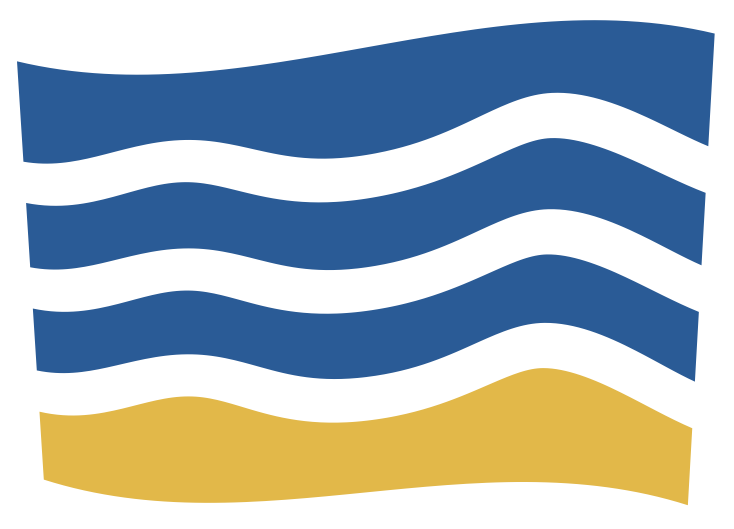We have a new committee for Porthtowan Beach Association (PBA) so decided we ought to know a bit more about our water quality and how our local works, quite literally, works.
One sunny Friday morning Chris Hines and Geoff Ward, Niki Willows and Abby Crosby met a knowledgeable chap from South West Water at our local treatment works. This is at Parc Shady and pretty much down the hill from Chris’ house.
Chris was a founding member of Surfers Against Sewage (SAS) and has been campaigning about water quality for many years. Geoff lives locally and was an early member of SAS. Chris sits on the Beach Association as Sewage expert and all round font of local knowledge. Abby is PBA Vice Chair, lives in Porthtowan and works for Cornwall Wildlife Trust. Niki lives in the village and was SAS Rep for three years and is now PBA Chair.
Preliminary Screening
We began our visit at the top of the works where the raw sewage comes in. To be honest I was expecting a thick mass and quite visible bits and bobs floating about but no, because of bath water, sinks and some surface water. It’s a flowing watery mix, quite brown though. This was a dry day at the end of a very dry month. It would look quite different after a lot of rain.
As this comes in there’s a section where anything solid that should not be flushed down the drains is pulled out mechanically. It’s deposited in a skip. This skip fills up every one to two months. Considering that this facility only serves Porthtowan and Mount Hawke I was really shocked. SAS have campaigned locally and nationally, I spoke to a whole class assembly at Mount Hawke School as part of the Plastic Free initiative and Abby and I have both worked with local schools on the beach. We thought we’d done a pretty good education job until we saw this skip.
I was incredulous that people still flush baby wipes, face wipes, moist toilet roll, sanitary products and nappies (yes, nappies!) down the loo. The only things that should be put into the loo are the Four P’s – Pee, Paper (loo paper!) Puke and Poo.
If people also decide to pour cooking oil and fat down the sink that can join together with the wipes and nappies to create a FATBERG! Here’s one in Sidmouth that is 64 metres long https://www.youtube.com/watch?v=xK9vMZ4QizM
This first stage is called Preliminary Screening.
Secondary Treatment
We walked along to the next stage where everything settles out, called Primary Settlement. At this point I have to say that there was no nasty smell at the works at all. I’d been expecting it and thought this seemed like a good time to wear a mask, but it was fine. I realise now that I should have taken a pen and paper to write down technical terms, but I’m afraid I didn’t. The mass from these tanks gets taken to a biodigestor at Hayle which creates energy. After the settling tanks we looked at the round tanks called Secondary Treatment, these have a big arm in the middle sprinkling the water down. In this tank are stones, loads and loads of them. And in amongst the stones are worms and bacteria that eat the sewage. The water drains out of these tanks a lot clearer than it went in.
UV Treatment
It then goes to a final settling tank just to get rid of any other solids – which I did wonder was just the worm poo from the previous tank! – and then into a magic UV disinfection system which kills off any viruses and bacteria that may be left behind. The water is then piped back into the stream which runs along the Scorrier Rd and through the village, across the beach and into the Atlantic.
I have to say that I was very impressed with the whole operation.
Sewage Spills
Sewage spill wise, if we have one, that is from the pumping station by the beach and not from the works at Parc Shady. The treatment works by the beach does now have monitors on and is much more efficient than it was previously. The works at Parc Shady have several alarms and electronic systems in place should any stage of the operation have an issue. It also has its own backup generator. The guy said that one of the worst things that can happen is if there is a chemical spill into the system and that will kill the creatures that do the work. If this happens they have to heavily dilute the water and reset the healthy bacteria.
All in all it was a very informative trip. Thanks to South West Water.
This is as I saw the works and in no way is a technical sum up of our visit. You can find out more at South West Water –
Education Team – https://www.southwestwater.co.uk/community/education-zone/team/
Water Saving Community Fund – https://www.southwestwater.co.uk/about-us/blog/blog-2021/weve-launched-the-water-saving-community-fund/
Niki Willows (with help from Chris Hines) May 2021







No comments yet.